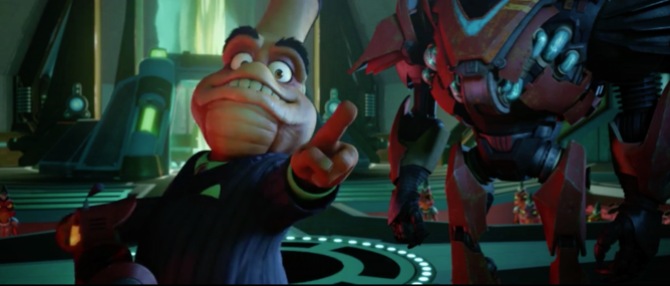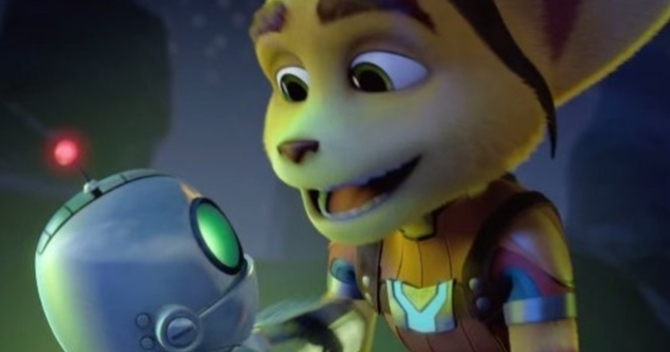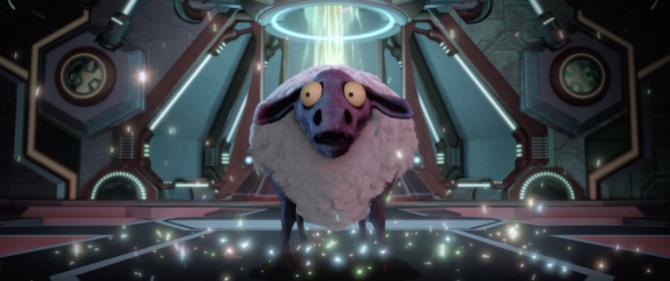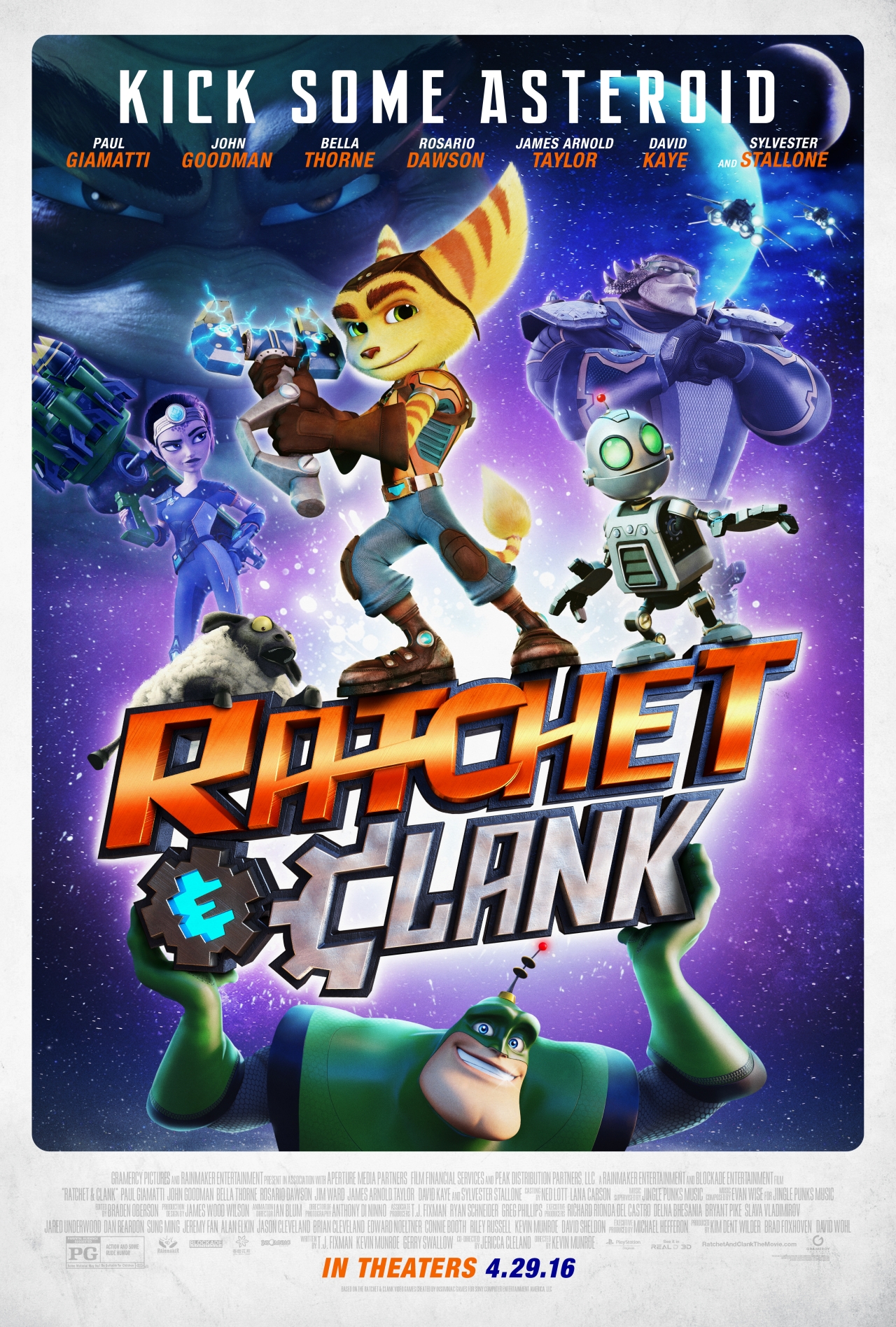Movies based on video games rarely receive warm welcomes, but Ratchet & Clank’s earnest treatment of a well-worn heroic journey is best described as forgettable but not awful: many of the jokes and action scenes feel like they’re working against their own film, but the whole production stays focused and makes too many acceptable design decisions to collapse entirely.
The story’s self-awareness extends to its jokes but not its basic structure.

The evil Chairman Drek oversees an enormous device that crumbles planets into fragments (once they’re uninhabited, this being a movie for very young children) shaped roughly like the state of South Carolina, which are to be reassembled into a patchwork planet of Drek’s very own. His actual reason for doing so isn’t given a lot of movie attention–his own planet has become polluted beyond repair. It’s a wonder the story, preachy as it is about heroism and doing the right thing, didn’t try to shoehorn in an environmental message.
As typical as the setup is, the narrative makes a surface-level attempt to poke fun at itself. The environmental-overlay captions you may have seen in any number of other sci-fi stories are used here, though they’re usually set up for gags, such as advertising for a gift shop or counting down to a villain’s big speech. The narrative, to its detriment, doesn’t leverage this toward any sort of atypical approach to its themes and its main conflict.
The titular Ratchet–a “Lombax,” a creature that partially resembles both a cat and a fox–works as a mechanic on his sparsely populated home planet of Veldin. We first see him making unauthorized upgrades to an old man’s ship, which quickly results in a very fast-paced runaway-car scene, itself a dead ringer for the pod race in The Phantom Menace. Ratchet is a rather selfish individual whose aspiration for super-heroic deeds outshines his mundane work ethic, but fortunately for his and the audience’s patience, this movie quickly contrives to give him the adventurous lifestyle he craves–sort of. The elite and heroic Galactic Rangers, led by the vain and incompetent Captain Qwark, happen to be holding candidate tryouts close to where Ratchet lives, which he quickly fails. (In the first game, Ratchet’s introduction to Qwark was fully playable, and the Galactic Rangers as such weren’t introduced yet. The film largely skips over the former and justifies the latter by way of their inclusion in later games.)

Clank is a small, adorable defect from what may as well be called Evil Robot Factory, who quickly turns against his creators to avoid his own destruction and is brought to Ratchet by circumstance. The two make a typical and usually likable buddy-comedy duo, except that in a film like this where even most of the heroes and Ratchet himself want to rely on brainless shoot-first tactics, Clank comes across as nearly everyone’s counter and is one of the story’s closest things to a moral compass. Most of the other rangers aren’t memorable in their names or personalities, but a notable exception is Elaris, a pretty associate who is rational, well-considered, and completely ill-suited for her coworkers who tend to ignore her’s and Clank’s pleas to actually think about their plans. Thankfully the story, which suits its franchise well, restrains itself enough not to shunt her off into a cringe-inducing romantic subplot or to make her a kidnapping victim.
The film is toned down enough to suit children without insulting parents.
Ratchet & Clank as a movie feels effectively censored from the games it’s based on: the twin heroes rarely actually do any in-combat shooting, with the first major robot fight being resolved by way of a huge magnet (and in fairness a huge ship explosion) despite being an actual dogfight in the game, and one of the few exceptions is when Clank’s electrocution of an enemy robot takes place mostly off-screen. The short amount of combat practice given to Ratchet is essentially him firing weapons at empty space, though it’s clear which shots exist to justify the 3D surcharge, which I didn’t bother paying. One of the most intense-for-children scenes comes in the form of red/blue laser spam that looks like it was ripped straight out of Star Wars’ The Clone Wars series.
For viewers and readers who haven’t played the games, wild and wacky weapon varieties are an extensive hallmark of the series, and while many of them are represented on-screen, the vast majority are used once if at all and rarely against organic life. One of the villains avoids a chance to easily kill Ratchet since … well, you know. The most notable of these instruments is the enemy-morphing Sheepinator, which is used one time and not even by Ratchet. However, the result is the one joke in the film that actually deserves being stretched for as long as it is. One of the first gags, dealing with gratuitous use of texting and social media (how much of either of those were you doing in 2002 when the first game came out?), gets stretched far beyond its breaking point, as do most of the others in the film, resulting in moments of relief when the attempts at humor become as fire-and-forget as the combat and plot are. Watch for Clank’s attempt to determine Ratchet’s species, which doubles as humorous advertising for other PlayStation games. Why didn’t Sony Pictures distribute this film? For series fans wondering about the R.Y.N.O. (“Rip You a New One,” which I’m surprised made it into the movie), it’s there but doesn’t really get used.
The film’s biggest issues are that 1) a lot of the jokes feel obnoxious, though this is because of overuse and not generally because of crudeness (the “kick some asteroid” pun on the poster is the worst of that, and there’s really no language or innuendo) outside of an off-screen vomit gag that makes sense for the context; 2) the simplistic presentation of a normally violent and sarcastic franchise–complete with brief footage of one of the games’ first-person multiplayer modes–feels like it’s meant for children who weren’t born when the series debuted; and 3) scenes hurry by in a frantic rush that doesn’t really give the audience time to be invested in the characters or plot events. The story does bother to slow down once for genuine tragedy before heading toward the climax, and doing so leads to its best moment and really its only glimpse of introspection.
Graphics that look good in a video game might not always pass muster for a movie, and production values are inconsistent here–while the music, animations, and character designs are fine, the light reflecting off of Captain Qwark’s suit and Clank’s metallic eyes looks like it’s being rendered at a low resolution, and particle effects (a nebula Ratchet gazes at, smoke, and–crucially for a film like this–fire) usually don’t look good. I don’t expect children or most adults to care about the low budget, however, and the film is colorful enough to look nice throughout–I find this particularly interesting since a number of the levels in the original game just didn’t look very good artistically. The vast majority of those are missing, though, as the story only visits a handful of locations, so what we as the viewers are left with is a plot that feels both heavily abridged and rather embellished–compared to the original game and not the remake–while adhering to its source material enough to remain recognizable. One of the presentation’s most aggravating design decisions is that most text within the movie is displayed as a very blocky ‘alien’ language that’s really just English in a hard-to-read typeface. This would be unappealing enough on its own, but certain subtle jokes are written on signs in this language and must be quickly deciphered in order for the audience to even understand that a punchline is even intended.

A number of subtle details are really well done, however, such as the ever-present crates commonly found in these games making several appearances, but that’s a double-edged sword since the film blatantly recycles some of its scenes (including part of the ending) from the PlayStation 4 remake of the original game, so it’s very likely that these art assets were simply reused. Hence, this film is most worth watching if you didn’t already spend the money to buy the game and the system to play it on and have no intention of doing so any time soon. Ratchet does have some of his characteristic gadgets, even if the story does Clank a disservice by lessening his importance, but don’t expect an explanation of where Ratchet got his grapple beam or his giant wrench, even as these things work as series fans should expect. At least Clank’s constant skeptical glances are funny as always.
Conclusion: This feels like a 94-minute commercial but is still a passable story.
Ratchet and Clank, as a movie, really feels like it’s 14 years too late. There’s not really a lot of character development, with Clank already being mature, Ratchet having an abrupt change of heart just like I recalled him doing in the original game but (now) much earlier in the storyline, the villains being gleefully evil just because they can be, and the writers doing as much as they can with Qwark while being stuck with his defining self-absorbed personality. The action isn’t bad, but much of it takes place out of frame in the style of Cars 2 without feeling quite so thematically inappropriate as it did in that film.
As stated, in trying to make a children’s film out of a franchise that counterbalances its talking-animal protagonist with an arsenal of weaponry and sometimes-crude humor (the last level of the original game was very grim), the filmmakers did arguably the best job they could with the limited premise and budget they were given, and the movie largely does a good job of remaining appropriate even for young audiences without usually becoming too scary or insulting the taste of older viewers. Considering how little of this film is original content even though it’s the franchise’s first, directors Kevin Munroe (2007’s TMNT and Jericca Cleland) at least deserve credit for not really squandering what little potential this project had. I have indeed seen MUCH worse executions of what’s largely the same story, so I’m counting my blessings. If you enjoyed the games and if you can’t play the new installment and if you’re not interested in watching cutscenes on YouTube, see this film once, and then go watch something with more ambition like the stellar How to Train Your Dragon 2 or Inside Out.

Image sources (property of Gramercy Pictures and Rainmaker Entertainment)
Movie poster – source
Chairman Drek – source
Galactic Rangers – source
Clank and Ratchet – source
Sheep – source
This post was originally written and published for my movie-review blog, Projected Realities.






